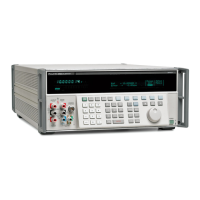Theory of Operation
Functional Description Presented by Output Function 2
2-7
2-10. DC Voltage Functional Description
The DAC assembly (A11) provides a stable dc voltage and is the basic building block of
the Calibrator. DC voltages are generated in six ranges:
• 220 mV
• 2.2V
• 11V
• 22V
• 220V
• 1100V
The 11V and 22V ranges are generated by the DAC assembly, with its output, DAC OUT
HI and DAC SENSE HI routed to the Switch Matrix assembly, where relays connect it to
INT OUT HI and INT SENSE HI. Lines INT OUT HI and INT SENSE HI connect to the
Calibrator binding posts by relays on the Analog Motherboard assembly (A3).
The 2.2V range is created on the Switch Matrix assembly by resistively dividing by five
the 11V range from the DAC assembly. Relays on the Switch Matrix and Analog
Motherboard route the 2.2V range output to the Calibrator binding posts.
The 220 mV range is an extension of the 2.2V range. The Switch Matrix assembly
resistively divides by ten the 2.2V range to create the 220 mV range. Relays on the
Switch Matrix and Analog Motherboard route the 220 mV range output to the front panel
binding posts.
The 220V range is generated by the DAC and Power Amplifier assemblies. The Power
Amplifier amplifies the 11V range of the DAC assembly by a gain of -20 to create the
220V range. The output of the Power Amplifier is routed to the High Voltage Control
assembly (A14), where a relay connects it to PA OUT DC. Line PA OUT DC is routed to
the binding posts via relays on the Switch Matrix and Analog Motherboard.

